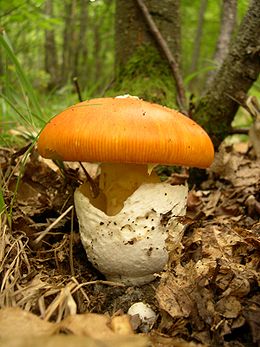Caesar's Mushroom: Difference between revisions
imported>Caesar Schinas m (Various minor grammatiacal changes) |
imported>Meg Taylor (move links to subgroup) |
||
| (2 intermediate revisions by 2 users not shown) | |||
| Line 1: | Line 1: | ||
{{subpages}} | |||
{{Taxobox | {{Taxobox | ||
| color = lightblue | | color = lightblue | ||
| Line 15: | Line 16: | ||
| binomial_authority = ([[Scop.]]) [[Pers.]] | | binomial_authority = ([[Scop.]]) [[Pers.]] | ||
}} | }} | ||
The '''Caesar's Mushroom''' (''Amanita caesarea'') is an edible [[mushroom]] in the family [[Amanitaceae]], native to southern [[Europe]]. The common name comes from its being a favorite of the [[Rome |Roman]] emperors, who took the name [[Gaius_Iulius_Caesar (name)#The_cognomen_Caesar|''Caesar'']] (originally a Roman ''cognomen'') as a title. Other common names include '''Royal Amanita''', '''Aminite de César''', '''Oronge''', or '''Kaiserling''' in German. | |||
The '''Caesar's Mushroom''' (''Amanita caesarea'') is an edible [[mushroom]] in the family [[Amanitaceae]], native to southern [[Europe]]. The common name comes from its being a favorite of the [[Rome |Roman]] emperors, who took the name [[Caesar]] (originally a | |||
This mushroom has a tawny cap with a yellow stem and gills. It may be seated in a cup (the remains of a [[universal veil]]) and have the remains of a partial veil hanging from the [[Stipe (mycology)|stipe]]. The base of the stipe is thicker than the top. The [[spore]]s are white. This mushroom favours [[oak]] woodland, sometimes mixed with [[conifer]]s. | This mushroom has a tawny cap with a yellow stem and gills. It may be seated in a cup (the remains of a [[universal veil]]) and have the remains of a partial veil hanging from the [[Stipe (mycology)|stipe]]. The base of the stipe is thicker than the top. The [[spore]]s are white. This mushroom favours [[oak]] woodland, sometimes mixed with [[conifer]]s. | ||
Caesar's Mushroom has also been classified as ''A. umbonata''. The relationship of the similar [[North America]]n species ''A. hemibapha'' and ''A. jacksonii'' to ''A. caesarea'' is not clear. Moreover, the edibility of North American species is also unclear. | Caesar's Mushroom has also been classified as ''A. umbonata''. The relationship of the similar [[North America]]n species ''A. hemibapha'' and ''A. jacksonii'' to ''A. caesarea'' is not clear. Moreover, the edibility of North American species is also unclear. | ||
Latest revision as of 09:39, 14 September 2013
| Caesar's Mushroom | ||||||||||||||||
|---|---|---|---|---|---|---|---|---|---|---|---|---|---|---|---|---|
 | ||||||||||||||||
| Scientific classification | ||||||||||||||||
| ||||||||||||||||
| Binomial name | ||||||||||||||||
| Amanita caesarea (Scop.) Pers. |
The Caesar's Mushroom (Amanita caesarea) is an edible mushroom in the family Amanitaceae, native to southern Europe. The common name comes from its being a favorite of the Roman emperors, who took the name Caesar (originally a Roman cognomen) as a title. Other common names include Royal Amanita, Aminite de César, Oronge, or Kaiserling in German.
This mushroom has a tawny cap with a yellow stem and gills. It may be seated in a cup (the remains of a universal veil) and have the remains of a partial veil hanging from the stipe. The base of the stipe is thicker than the top. The spores are white. This mushroom favours oak woodland, sometimes mixed with conifers.
Caesar's Mushroom has also been classified as A. umbonata. The relationship of the similar North American species A. hemibapha and A. jacksonii to A. caesarea is not clear. Moreover, the edibility of North American species is also unclear.